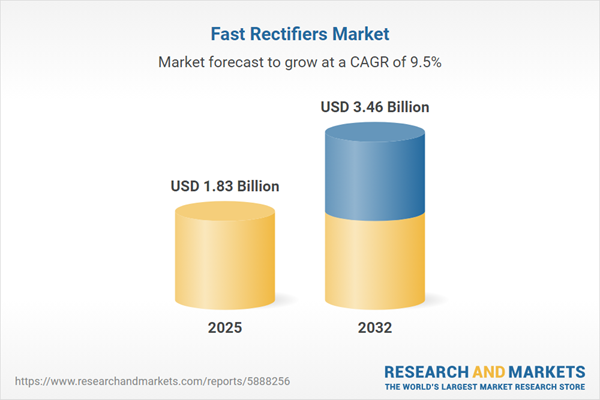Speak directly to the analyst to clarify any post sales queries you may have.
The fast rectifiers market is undergoing significant transformation, with supply chain complexity, regulatory demands, and digital innovation shaping procurement and operational strategies for senior decision-makers. Today’s leadership focus is on optimizing sourcing, gaining actionable market insight, and maintaining operational agility to navigate evolving industry pressures.
Market Snapshot: Fast Rectifiers Market Growth and Competitive Landscape
Steady expansion characterizes the global fast rectifiers market, driven by continued investments in power electronics and digital infrastructure modernization. Executive teams are reevaluating power management systems to comply with dynamic regulations and to leverage digital transformation. Market competition intensifies as renewable energy adoption accelerates, pushing organizations to streamline supply chains and reduce development cycles. With digitalization influencing operational models, expectations for rapid innovation and adaptable business strategies remain elevated. Increasing global interconnectivity compels organizations to adopt more robust sourcing and risk management protocols, ensuring long-term stability in a swiftly changing sector.
Scope & Segmentation: Fast Rectifiers Market Analysis
Precise market segmentation equips decision-makers with the insights necessary for mitigating risks, uncovering strategic opportunities, and managing sourcing efficiently in the fast rectifiers sector. Each segment underscores key considerations impacting supply chain decisions and technology adoption:
- Product Types: Single phase fast rectifiers fulfill moderate loads at lower scales, while three phase units address high-capacity needs in automation and telecom solutions.
- Package Types: Enclosure options such as DO-15, DO-41, SMA, and SOD-123 offer versatility to address a range of circuit configurations and mechanical environments.
- Applications: Fast rectifiers are essential for automotive charging, consumer electronics, backup power systems, infotainment, industrial control, and telecom infrastructure where system reliability is key.
- Current Ratings: A broad offering ranges from compact units under 1A to robust types exceeding 10A, supporting portable devices through to industrial machines.
- Voltage Ratings: Coverage spans low, medium, and high voltage applications to accommodate specialist requirements and complex system demands.
- End Users: The appliance, lighting, power supply, and renewable energy sectors remain major demand sources, directly affecting procurement cycles and component selection strategies.
- Regional Markets: Growth patterns and regulatory focus differ notably across the Americas, Europe, Middle East & Africa, and Asia-Pacific, shaping local sourcing and market entry tactics for fast rectifier suppliers.
This segmentation supports more agile sourcing, refined risk management, and adaptable strategic planning across the market’s expanding regional and application diversity.
Key Takeaways for Senior Decision-Makers
- Wide bandgap semiconductors, notably silicon carbide and gallium nitride, are advancing operational efficiency and thermal management for high-demand digital and industrial use cases.
- Digital diagnostics paired with embedded sensor technology increase visibility into real-time operations, reducing downtime and supporting predictive maintenance priorities.
- Sustainable procurement practices are gaining priority, supporting organizational ESG objectives and providing greater assurance across multi-tiered supply networks.
- Growing demand for customization in fast rectifier solutions is ensuring durability and performance, especially in specialized operational environments.
- Strategic partnerships have become essential for quickly adapting to changing regulations and market conditions.
- Agile supply chain frameworks are enhancing resilience, enabling businesses to respond effectively to regulatory and market transitions.
Tariff Impact: Navigating Regulatory Shifts
Shifting US tariff policies are prompting fast rectifiers market participants to refine sourcing strategies, with increased interest in favorable trade zones and domestic manufacturing options. Changes in inventory approaches and a sharpened focus on local distribution networks have helped organizations stabilize costs and address evolving global trade requirements effectively.
Methodology & Data Sources
This market analysis is based on a thorough examination of executive interviews, regulatory and financial records, and input from technical experts. The resulting synthesis offers reliable perspectives for strategic leadership decisions.
Why This Report Matters for the Fast Rectifiers Market
- Enables leadership to synchronize strategies with digital transformation, supporting efficient investment planning for business adaptability and growth.
- Bolsters supply chain resilience by equipping procurement managers to adjust methodologies in response to regulatory changes and local market dynamics.
- Provides segmentation-led insight to guide timely decisions and targeted prioritization as new market technologies emerge.
Conclusion
Market success in fast rectifiers relies on innovation, operational adaptability, and strong attention to compliance. Leaders who proactively integrate these principles are positioned to achieve lasting competitive advantage.
Additional Product Information:
- Purchase of this report includes 1 year online access with quarterly updates.
- This report can be updated on request. Please contact our Customer Experience team using the Ask a Question widget on our website.
Table of Contents
3. Executive Summary
4. Market Overview
7. Cumulative Impact of Artificial Intelligence 2025
Companies Mentioned
The companies profiled in this Fast Rectifiers market report include:- Infineon Technologies AG
- STMicroelectronics N.V.
- ON Semiconductor Corporation
- ROHM Co., Ltd.
- Diodes Incorporated
- Vishay Intertechnology, Inc.
- NXP Semiconductors N.V.
- Microchip Technology Incorporated
- Toshiba Corporation
- Mitsubishi Electric Corporation
Table Information
| Report Attribute | Details |
|---|---|
| No. of Pages | 181 |
| Published | October 2025 |
| Forecast Period | 2025 - 2032 |
| Estimated Market Value ( USD | $ 1.83 Billion |
| Forecasted Market Value ( USD | $ 3.46 Billion |
| Compound Annual Growth Rate | 9.5% |
| Regions Covered | Global |
| No. of Companies Mentioned | 11 |








